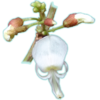Solori
Lianas or trees. Twigs usually lenticellate. Leaves imparipinnate; stipules present, persistent or caducous; stipellae generally present or sometimes reduced, persistent. Leaflets generally more than 7, up to 41 (or rarely more) per leaf, opposite, entire. Inflorescences axillary pseudoracemes, often combined with terminal or axillary pseudopanicles, intermediate form only found in B. koolgibberah. Flowers usually more than 5, occasionally 2 or 3, fascicled on (or rarely on the top of) callose, knob-like or club-shaped brachyblasts. Bracts subtending brachyblasts and flowers persistent or caducous, shorter than the corresponding flower buds; bracteoles present, usually at the apex of the pedicel or at the base of the calyx. Calyx cup-shaped, often greenish or slightly reddish, bilabiate, upper lip 2-lobed, often indistinctly so; lower lip 3-lobed. Corolla whitish, pinkish or purplish; standard without distinct basal callosities, reflexed at base; wings approximately as long as keel petals and adherent by lateral pockets or hooked together by auricles or twisted claws (or any combination). Stamens 10, monadelphous, with basal fenestrae; anthers all equal, fertile, glabrous. Disc usually distinct, tubular, cylindric or 10-lobed. Ovary with 7–12 ovules. Pods indehiscent, thin and stiff, usually narrowly elliptic or strap-like, with a wing along the upper suture only; seed chambers distinct. Seeds bean-shaped, 1–4 or 7; hilum usually central.

Figure 1. A, majority-rule consensus tree from Bayesian analysis of all combined molecular and morphological datasets; B, majority-rule consensus tree from Bayesian analysis of the complete molecular dataset. — Numbers below branches are bootstrap support (BS) values and numbers above branches are Bayesian posterior probabilities (PP). Abbreviation of genera: A., Aganope; Au., Austrosteenisia; D., Derris; Da., Dalbergia; Deg., Deguelia; F., Fordia; K., Kunstleria; L., Lonchocarpus; Lep., Leptoderris; M., Millettia; N., Neodunnia; O., Ostryocarpus; P., Paraderris; Ph., Philenoptera; Pi., Piscidia; Pon., Pongamiopsis; S., Solori. Capital letters: “A”, Aganope clade; “D”, Derris major clade (containing also Paraderris subclade) and “DP”= the subclade containing Paraderris species [except D. (P.) laotica]; “S”, Solori clade; “ST”, Solori subclade containing tree-like species; “SL”, Solori subclade containing liana species [1].

Figure 3 Ancestral area reconstruction (AAR) of the Brachypterum (Solori) and Derris clades (Lagrange). Numbers at nodes represent node names. Grey boxes indicate reconstructions which received very low (≤ 0.1) relative probability (RP) (nodes 56, 72, 76). Black boxes represent numerous, poorly supported optimizations (nodes 43, 55 and 71). Different AAR results by S-DIVA are indicated by circles and pie charts (see Table 1). At node 68 the pie chart indicates the equal marginal probability (25%) of the area combinations BCDE, BCE, CDE and CE. B, Brachypterum (Solori) clade; BNA, New Guinea–Australian Brachypterum (Solori) subclade; BT, ‘tree habit’ Brachypterum (Solori) subclade; DI, Derris subclade 1 including Paraderris; DII, Derris subclade 2 containing the majority of Derris species sensu Geesink (1984); P, Paraderris clade nested within DI. Abbreviation of genera: B., Brachypterum (Solori) ; D., Derris; F., Fordia; M., Millettia [2].
References
- , “Molecular and morphological phylogenetic reconstruction reveals a new generic delimitation of Asian Derris (Fabaceae): Reinstatement of Solori and synonymisation of Paraderris with Derris”, Taxon, vol. 63, pp. 522–538, 2014.
- , “Historical biogeography of Aganope, Brachypterum and Derris (Fabaceae, tribe Millettieae): insights into the origins of Palaeotropical intercontinental disjunctions and general biogeographical patterns in Southeast Asia”, Journal of Biogeography, vol. 41, no. 5, pp. 882 - 893, 2014.
This genus comprises about 12 species. The type species, Solori scandens (Roxb.) Sirich. & Adema is a common and widespread species ranging from Reunion island to India, Sri Lanka, Bangladesh, Myanmar, throughout Indochina, throughout Malesia, to N. Australia, with some endemic species e.g. Solori cumingii Sirich. & Adema and B. philippinensis Sirich. & Adema are endemic to the Philippines. Three species, B. koolgibberah Sirich. & Adema, B. pseudoinvolutum Sirich. & Adema and B. submontanum Sirich. & Adema are endemic to Papua New Guinea and B. involutum Sirich. & Adema is endemic to Australia.
Species of this genus grow in various kinds of vegetation such as primary and secondary forest, mixed deciduous forest, edge of dry evergreen forest, grassland, agricultural areas, in fully exposed or semi-shaded, very disturbed or degraded areas, along roads or waterways.
